The planetary nebula Abell 80, AKA PN G102.8-05.0, is located in Lacerta. The only distance estimate I found for it puts it at 1.9 kpc (6,200 light-years). http://articles.adsabs.harvard.edu//full/2005MNRAS.357..619P/0000624.000.html Visually it is very faint with reports of seeing it in a 16 being about a 50-50 deal. While it is often described as being a ring I get more of a sense of a cylinder tilted downward (north up). This would explain why the sides are strong but the top and bottom rather weak. Also, the weak top and bottom areas are about the same length as the bright side regions.
Color images I found on the net failed to show the very faint, very blue, central star. Most likely because they used H alpha for the luminance data. This one was so faint I did have to augment the image with H alpha data but I used only LRGB data for the stars in order to not lose the central star. The center hole has a slight blue cast probably due to OIII emission that is often seen in the center of ring planetaries. Not having an OIII filter I can't say for sure.
14" LX200R @ f/10, Ha=3x30' L=4x10' RGB=2x10', STL-11000XM, Paramount ME | 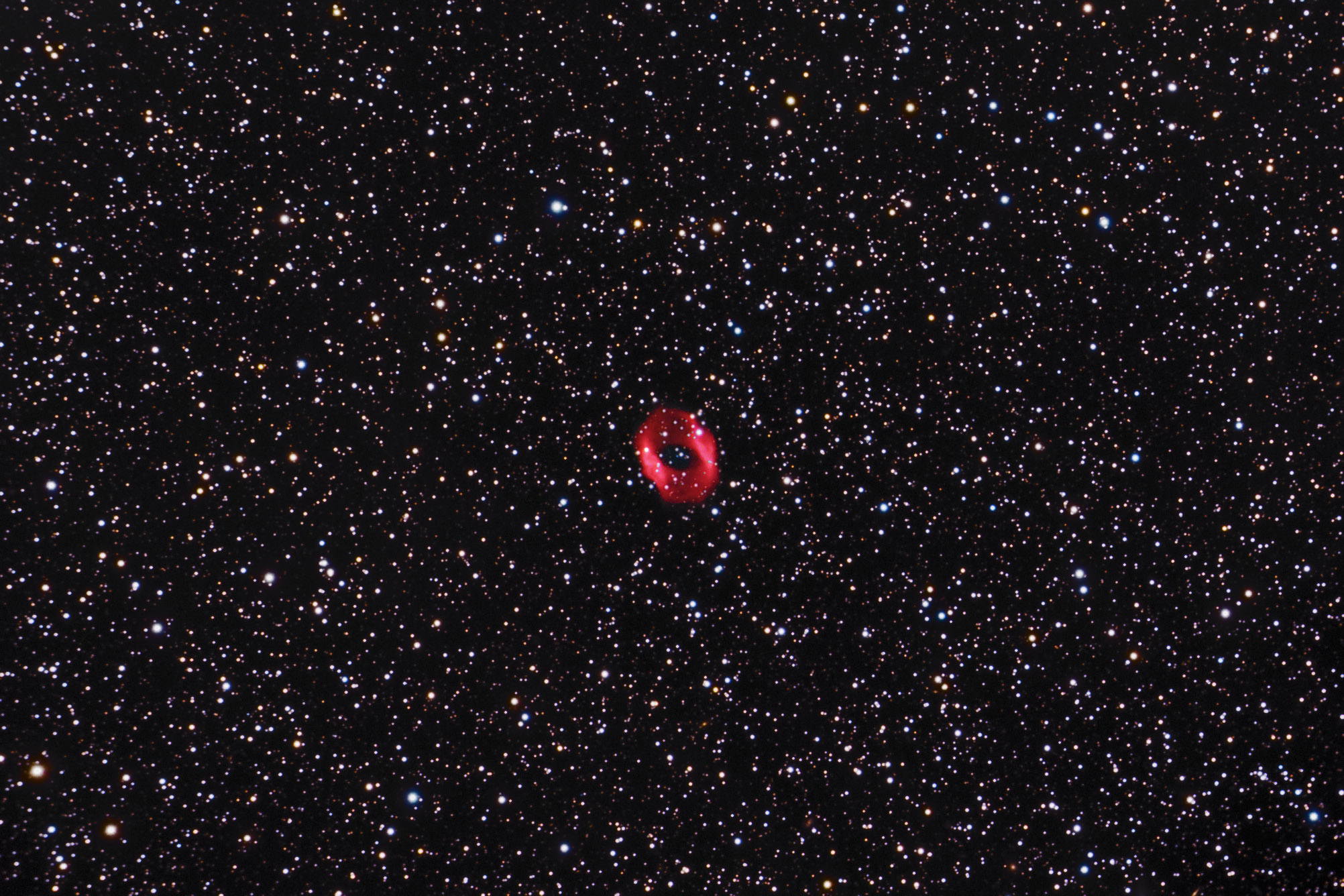
PNABELL80HA3X30L4X10RGB2X10R.JPG
| Abell 82 is a planetary nebula in western Cassiopeia about 1000 light-years by the only measurement I could find. The central star is a puzzle being a K0 subgiant star by this paper http://www.aanda.org/articles/aa/full_html/2011/02/aa13984-09/T4.html . Their table lists two K0 and two K3 stars along with a few M class central stars. This goes against the central star being a white dwarf so what's wrong? A K0 subgiant shouldn't put out enough UV to excite a SN. Besides, its the outer envelope being blown off that forms the PN yet a K0 star still has its outer shell. I have no idea how this can happen. Is the central star a double star in which the white dwarf is swamped by the much brighter giant or subgiant star? Is the central star too faint and there just happens to be a handy nearby one that gets tabbed for this? The planetary's size in my LRGB image is 80" of arc which makes it about 0.39 light-years across. This doesn't consider the faint ears seen in OIII light. They give it a diameter of about 113" for a size of 0.55 light-years assuming the 1000 light-year distance is correct. Lots of ifs in this so the error could be substantial.
I had started this one years ago but only got a couple frames. Somehow it never was finished until I was reminded of it by a narrow band post by Derek Santiago http://www.pbase.com/dsantiago/image/160958220 . That got it back on my to-do list. Last October I managed to get it in LRGB and then in January get some H alpha data. Not having an OIII filter I wasn't able to pick up the "ears" that Derek did. Not having seen anyone try it in LRGB I had to see what that would show. I then added the H alpha data which pretty much wiped out the OIII even in the parts where OIII is stronger than H alpha since I couldn't isolate that frequency. Adding the H alpha brought out its classic "apple core" appearance. Each has something to offer. Note that the H alpha filter at 6nm bandwidth also picks up NII emission which is often found in planetary nebulae. How much of the red is H alpha and how much NII I don't know.
There's nothing else in the field worth mentioning that I noticed so I didn't prepare an annotated image.
14" LX200R @ f/10, L=4x10' RGB=2x10', HA=4x30', STL-11000XM, Paramount ME | 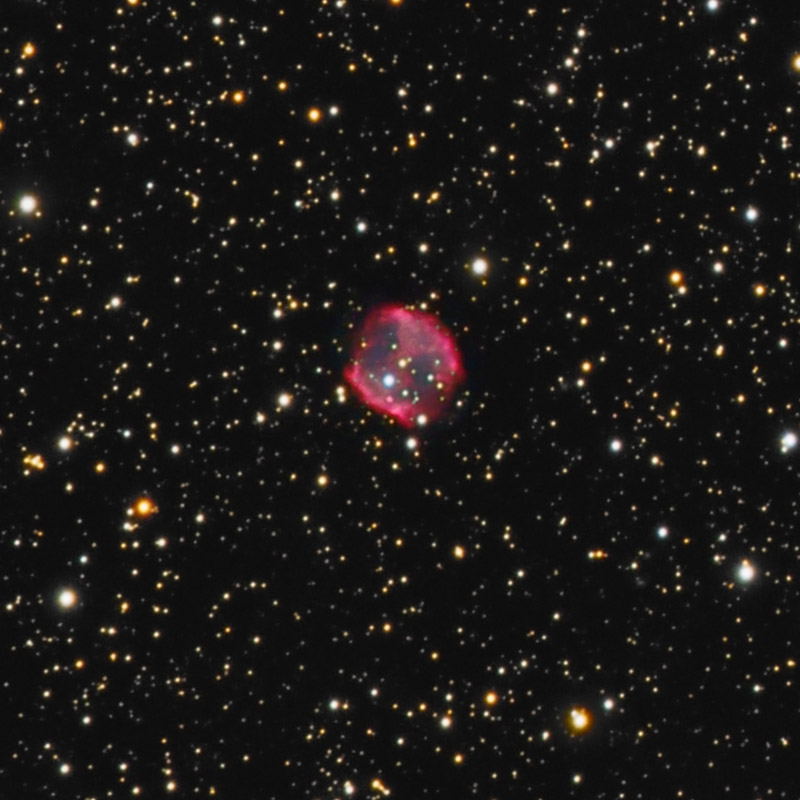
PNABELL82L4X10HA4X30RGB2X10R-CROP125.JPG
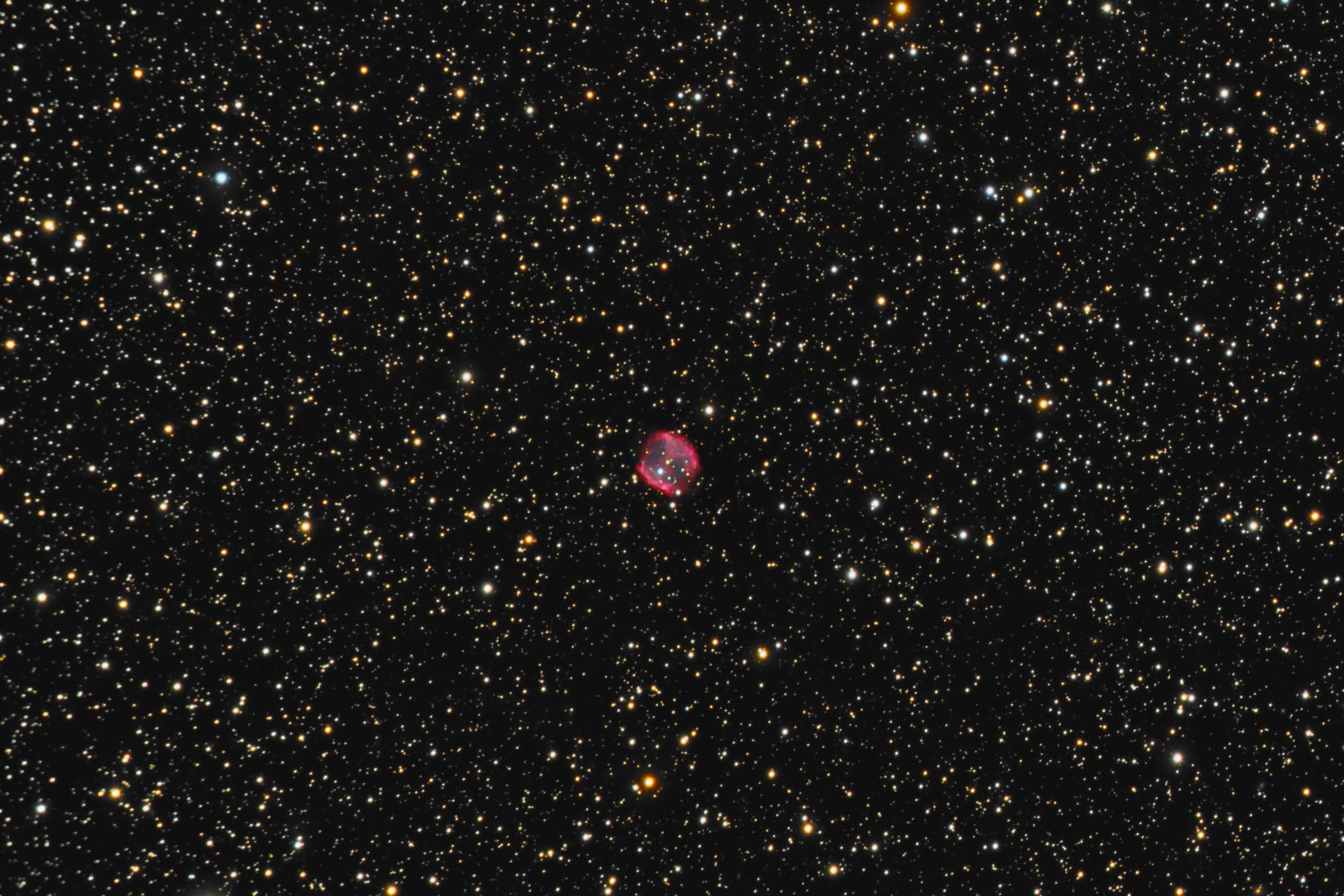
PNABELL82L4X10HA4X30RGB2X10R.JPG
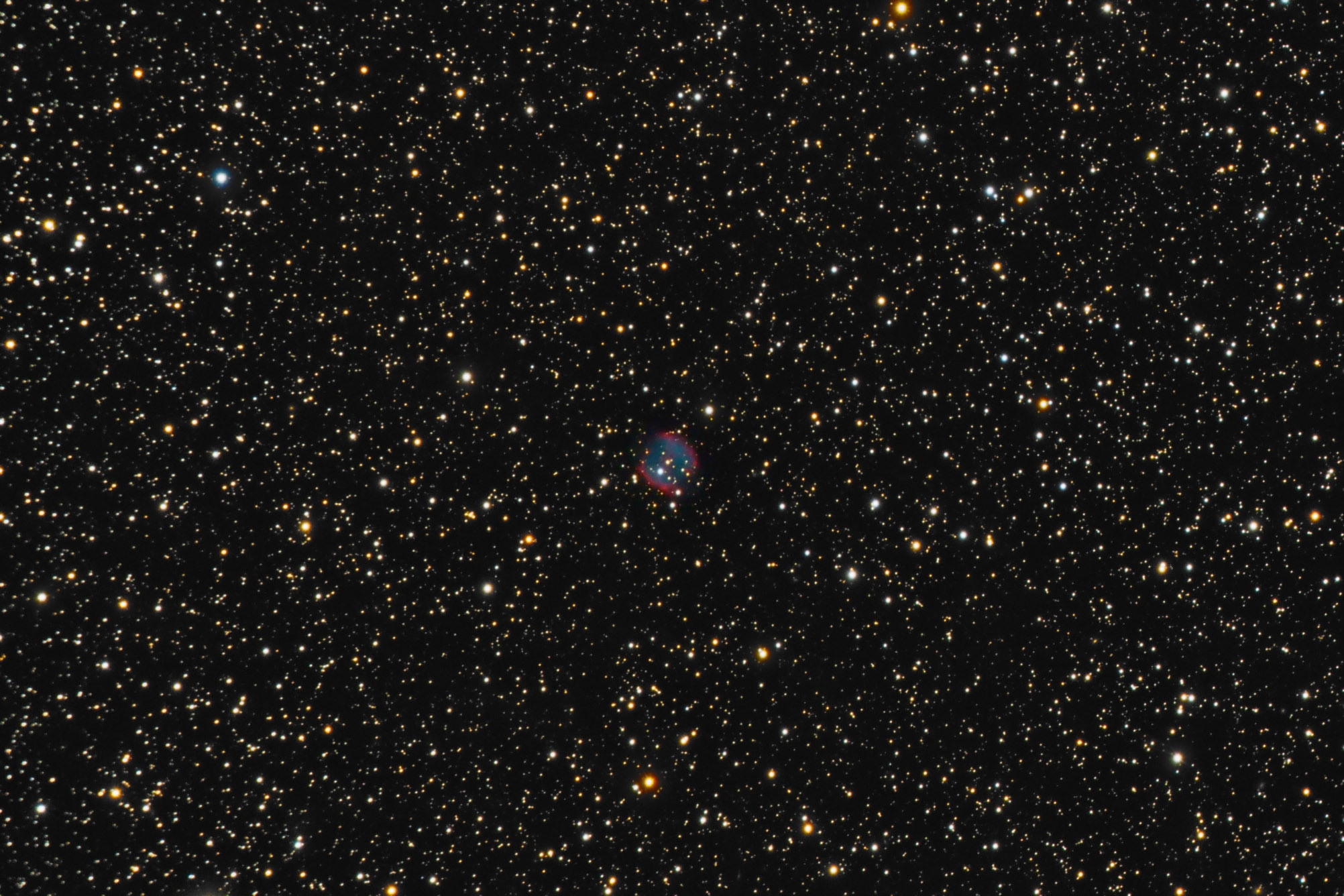
PNABELL82L4X10RGB2X10.JPG
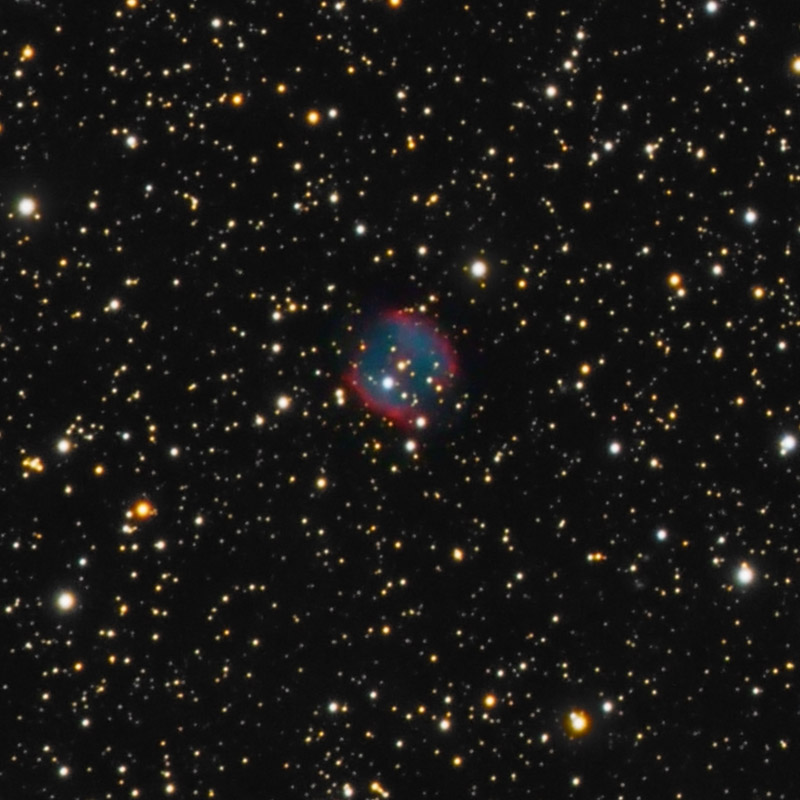
PNABELL82L4X10RGB2X10CROP125.JPG
| I've always updated my image of Gyulbudaghian's Nebula, a variable nebula, about once a year. I took this year's version in July earlier than usual hoping to try again in a few months. It didn't get processed until earlier this month which reminded me I was going to try again. Unfortunately conditions so far this month have been very bad. Fog and haze moved in even as the first frame was starting. I ended up taking 8 luminance frames none of which were very good but combining all 8 I sort of got something useful. There were nasty fog halos around bright stars I sort of dealt with. Removing them but not the nebula behind them was quite a challenge. Color data was very poor due to the fog. I about gave up on processing this but finally managed to get something useful by using the color data from last July so if it changed color this image won't show that. I could try again once the moon is out of the way. If so that would give a very short term view of how it changes. Looking at the November 8 image it looks much like it did a year ago rather than as it did in July. So it may very well show variations in only two or three weeks time. If the weather ever cooperates maybe I can find out. But it's biggest change appears to be in PV Cephi itself. Being a protostar it is an irregular variable commonly running about magnitude 16.5 but with sudden peaks to 15 and slow dips to 18th magnitude. Except for this image all the others appear rather constant at mid 16th magnitude. Due to it being embedded in nebulosity I can't get a good measurement but it appears about 14.8 in my images which would put it near a typical maximum. Something none of my other images have caught before.
For more on this nebula see my November 4th post
14" LX200R @ f/10, L=8x10' RGB=2x10', STL-11000XM, Paramount ME Related Designations for PVCEPPV Cep, IRAS 20453+6746, IRAS F20453+6746, AKARI J2045533+675743, PVCEP, 12, 13, 14, 15, 15N, | 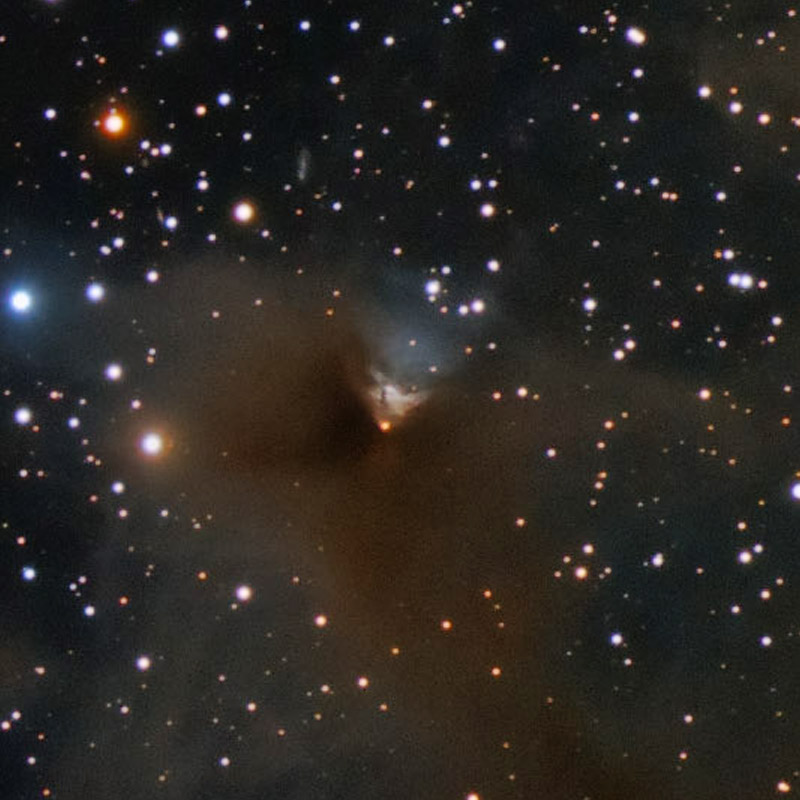
PV-CEPL8X10RG2X10B4X10R1-CROP150.JPG

PV-CEPL8X10RG2X10B4X10R1.JPG
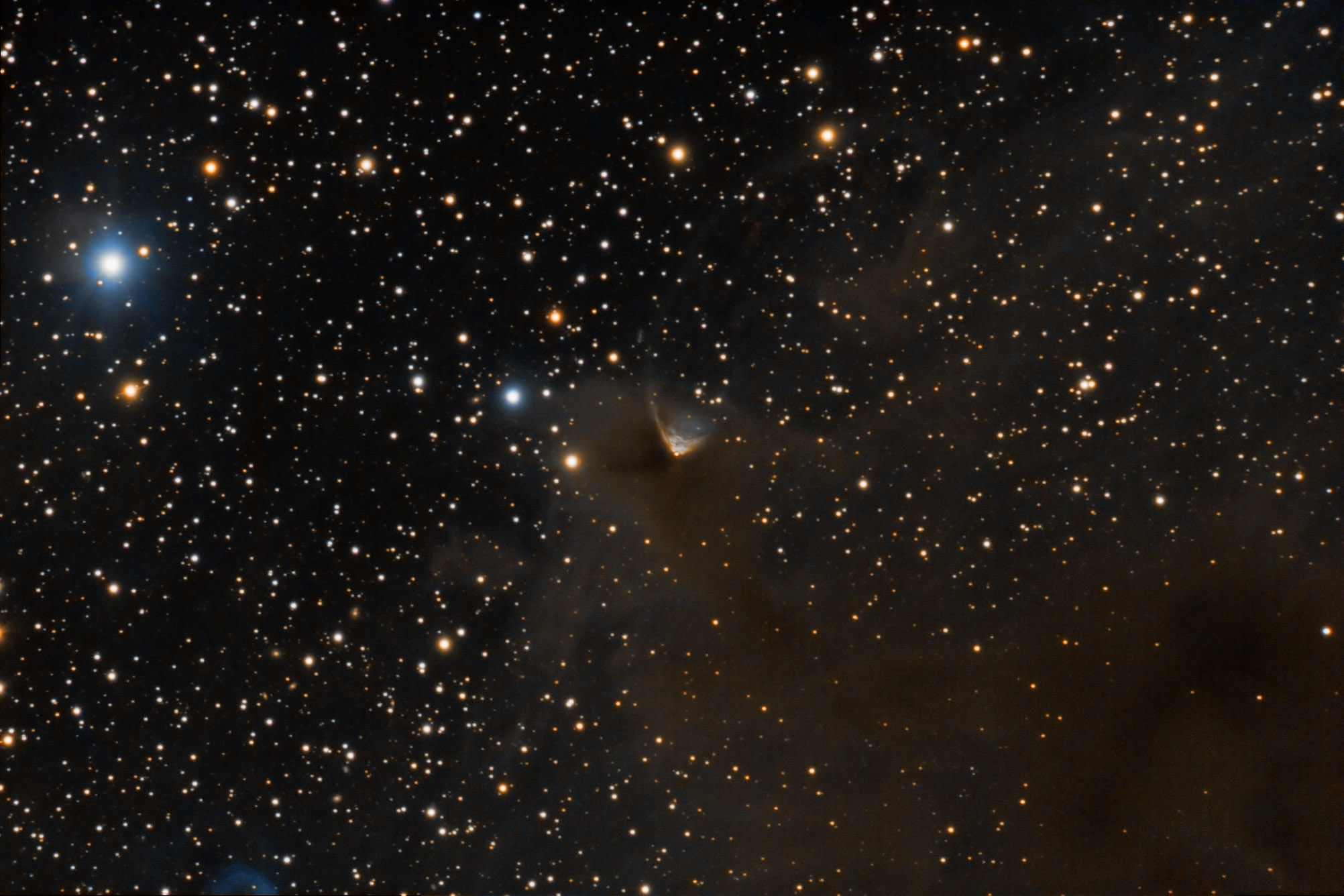
PVCEPHI_L8X10RGB2X10.JPG
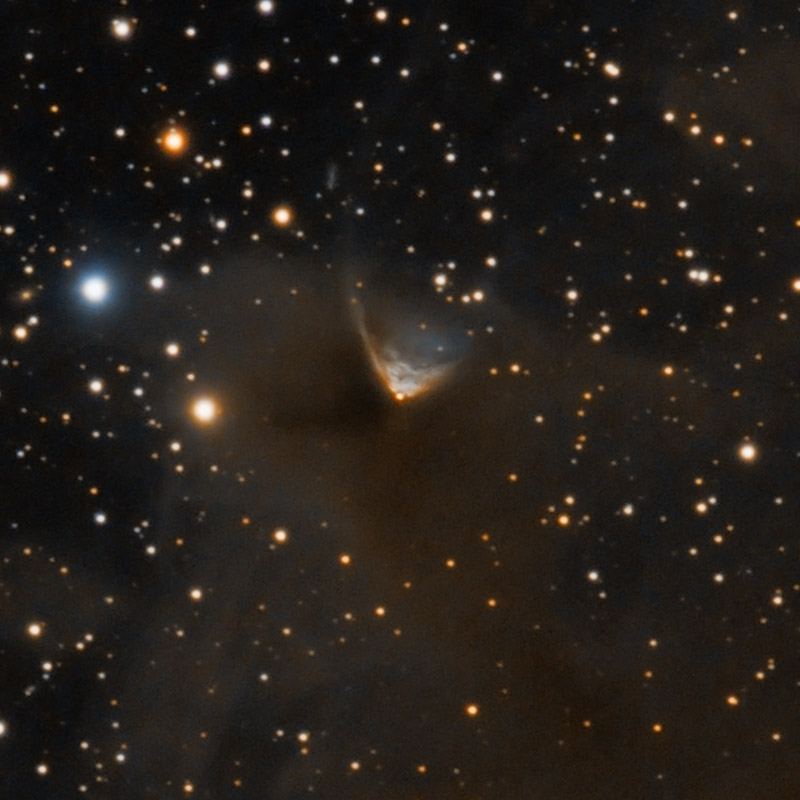
PVCEPHI_L8X10RGB2X10CROP125.JPG

PVCEPHI_L8X10RGB2X10ID.JPG
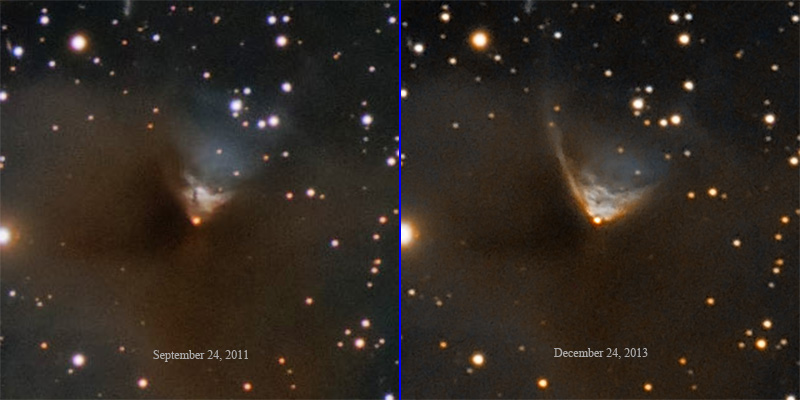
PV_CEPHI_COMPARE.JPG
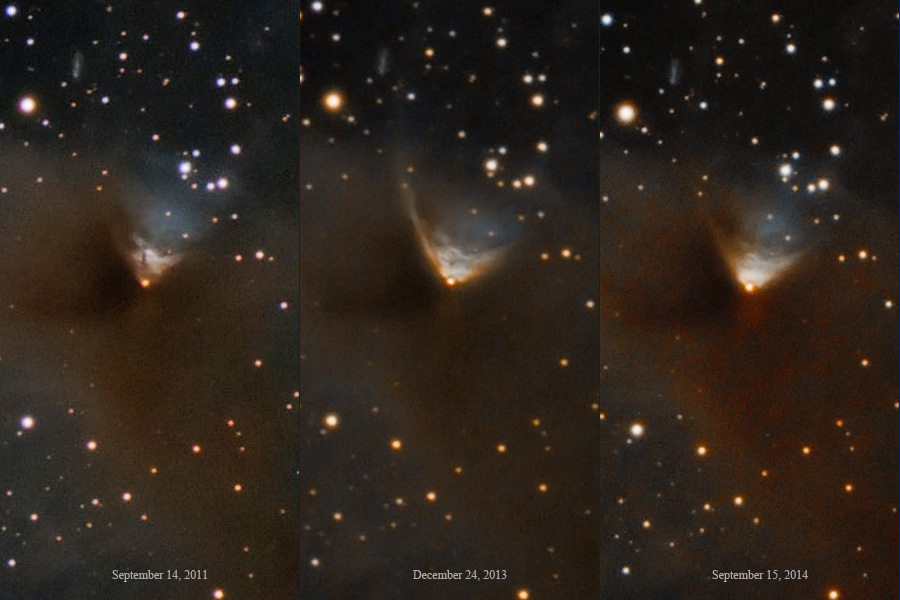
PV_CEP2011-14.JPG
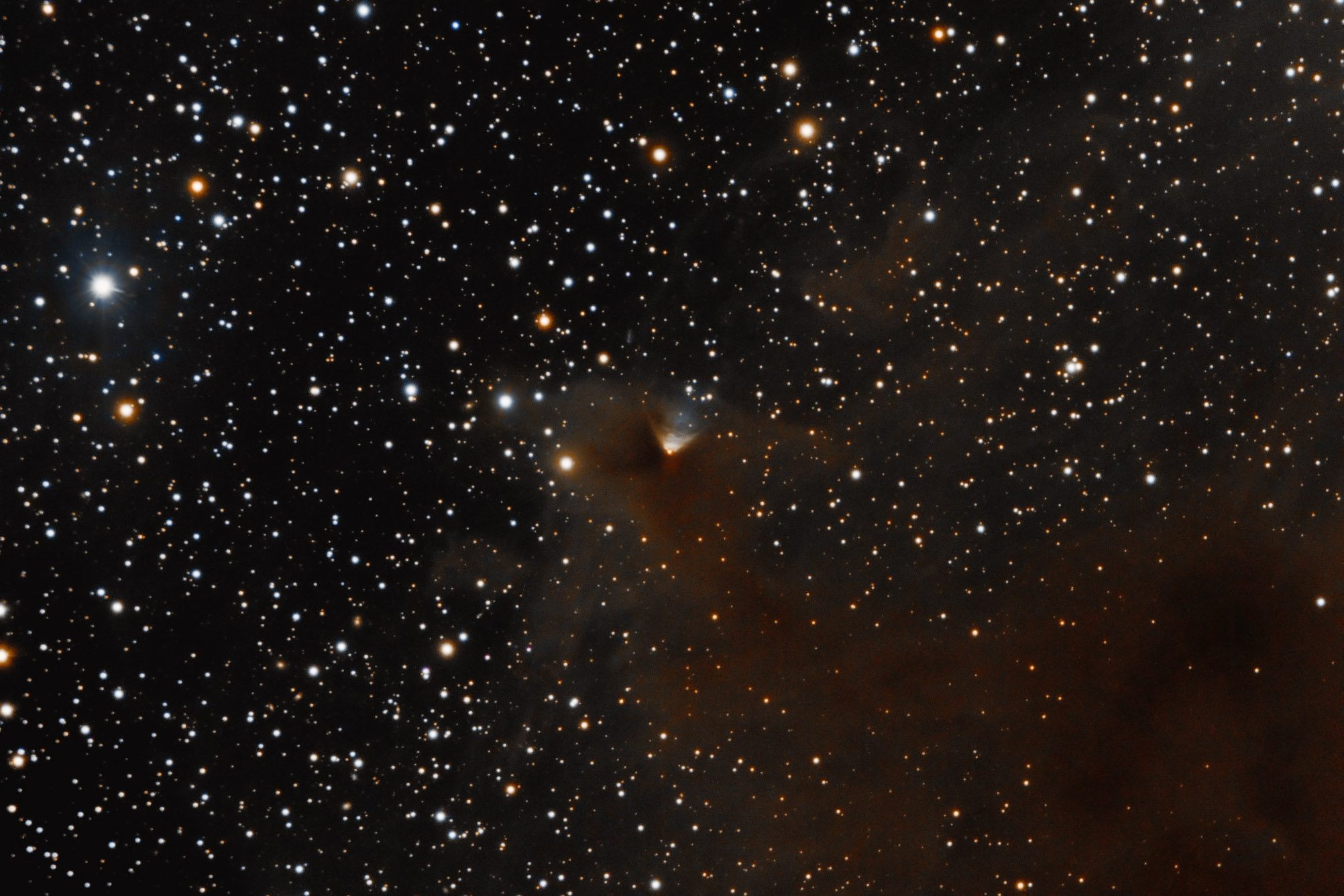
PV_CEPL8X10RGB2X10.JPG

PVCEPH15L5X10RGB2X10R.JPG

PV_CEP2011-15.JPG
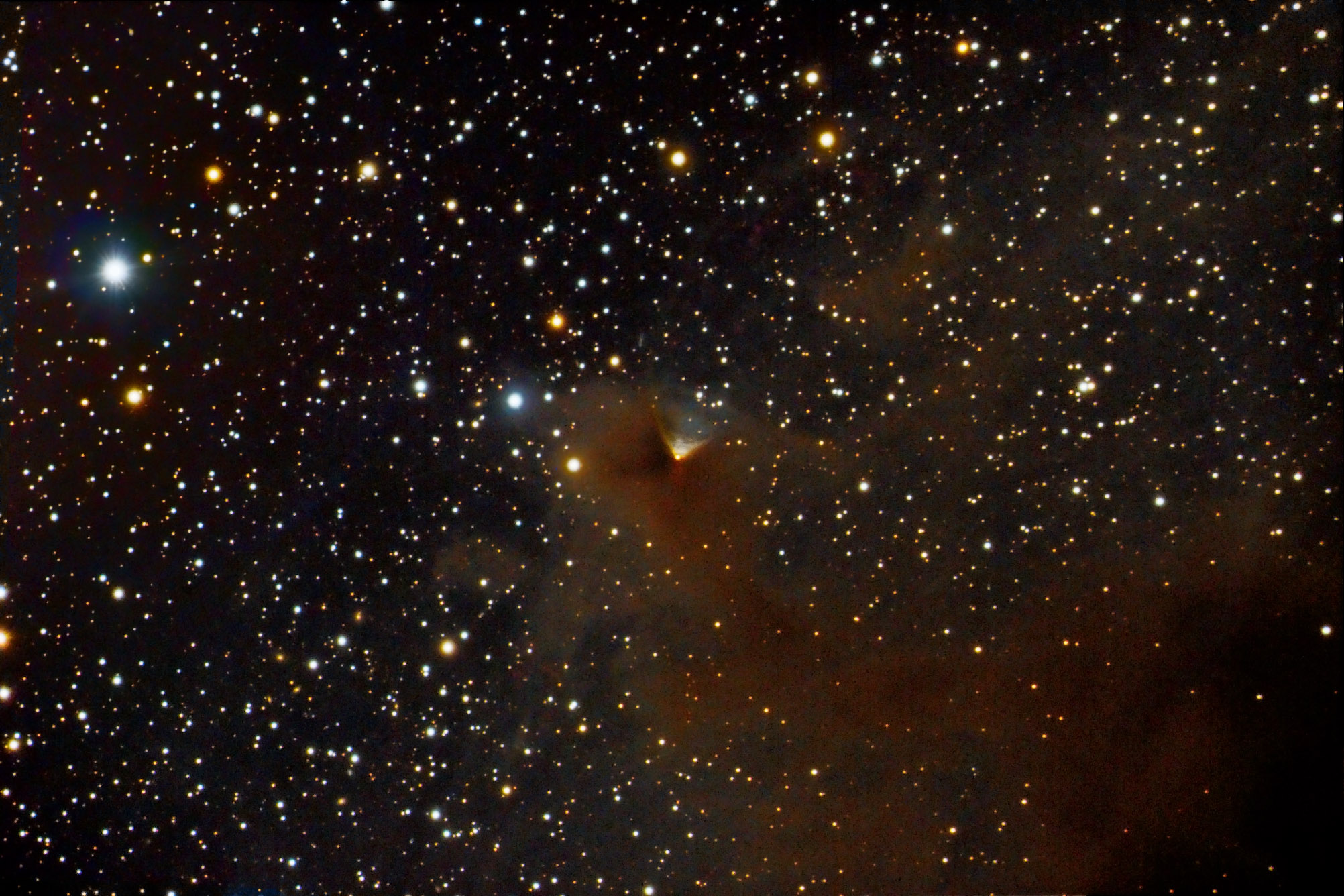
PVCEPHI-L8X10RGB2X10N.JPG
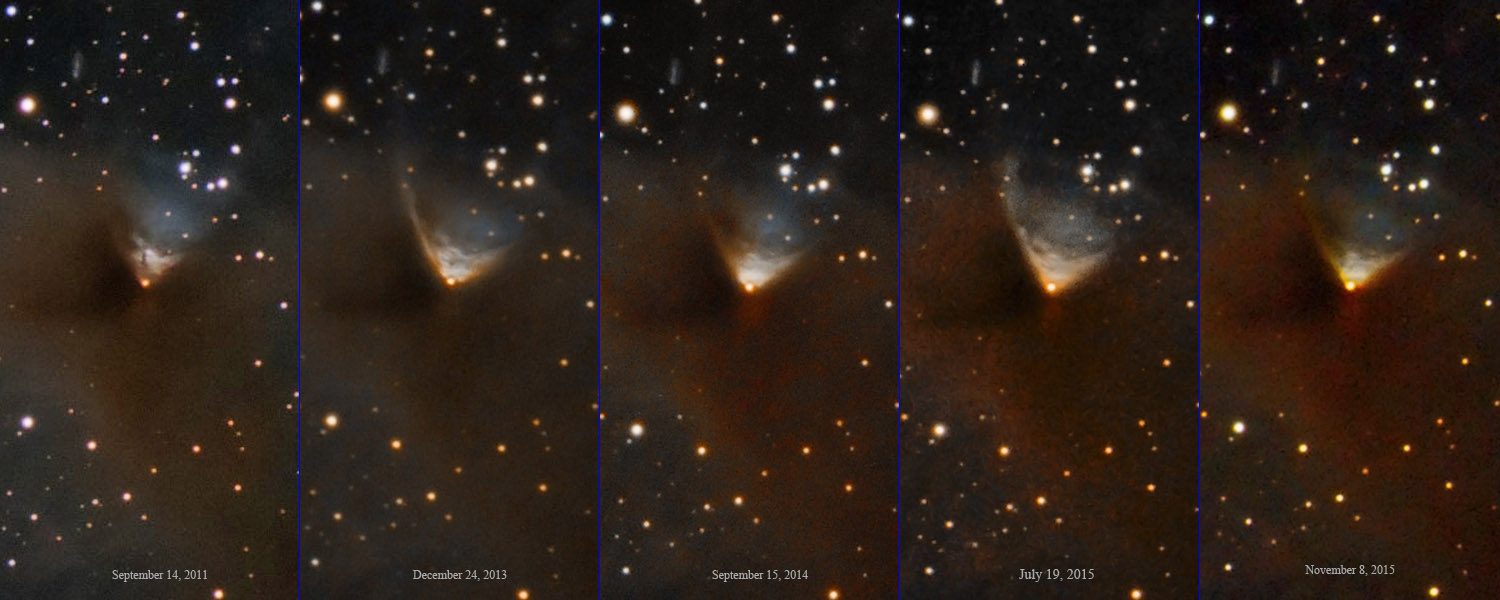
PV_CEP2011-2015NOV.JPG
| I've been monitoring the nebula around PV Cephi (Gyulbudaghian's Nebula) since 2011. Each year changes are seen but nothing nearly as dramatic as when my images are compared to the POSS I and POSS II images. In the POSS II images it is nearly invisible in red light as a streak with a bit more even fainter features but in blue it is rather similar to the brighter parts seen in all my prior images so it was very blue back in the mid 60's when those were taken. But since they could have been taken a year or two apart this isn't saying much. In the 1950's when the POSS I plates were made the streak of red light was much stronger with little else seen. It was also seen in blue light but was much weaker so then the streak was quite red.
I was in for a surprise when the first frame for 2017 came in. It had changed drastically with the streak portion seen in three of the POSS images being the main feature though the eastern half of the triangular part of the nebula was visible it no longer reached PV Cephi itself with much of the western side very faint. PV Cephi itself is much fainter than in any of my prior images.
Also, the dark nebula seems to have changed being less bright with weaker color. The lower right part of the cloud is LDN 1155C. The portion nearer PV Cephi may be [YDM97] CO 8. I'm not all that great at identifying these dark nebulae.
Above Gyulbudaghian's Nebula is a separate short streak. It is unrelated as it is HH 415 due to a jet from a protostar at its south end. Though the star likely formed from the same molecular cloud that fills much if the field. Gyulbudaghian's Nebula is just a part of it lit by PV Cephi. It likely changes due to dark clouds right around PV Cephi which itself is a young stellar object and thus a variable star.
An interesting paper suggests that PV Cephi formed in the NGC 7023 star cluster and was ejected about 100,000 years ago and entered the molecular cloud in which we now see it about 35,000 years ago. http://iopscience.iop.org/article/10.1086/383139
Besides this year's image, I've included comparison images, processed as similarly as possible for me, going back to 2011 showing how it has changed. Note the "streak" remains rather constant while the rest seems to change significantly. The star and its nebula are thought to be about 1600 light-years away. As the name indicates it is in Cephius near the western edge. Not far from the Iris Nebula.
While several have made "movies" of Hubble's Variable Nebula changing in just a couple days I find no such movie for this nebula. Its changes seem greater than of Hubble's Variable Nebula. Someone with more consistent skies than I have needs to undertake this task.
14" LX200R @ f/10, L=4x10' RGB=2x10', STL-11000XM, Paramount ME | 
PV2016L4X10RGB2X10.JPG

PV_CEP2011-2016.JPG

PV_CEP2011-2017.JPG
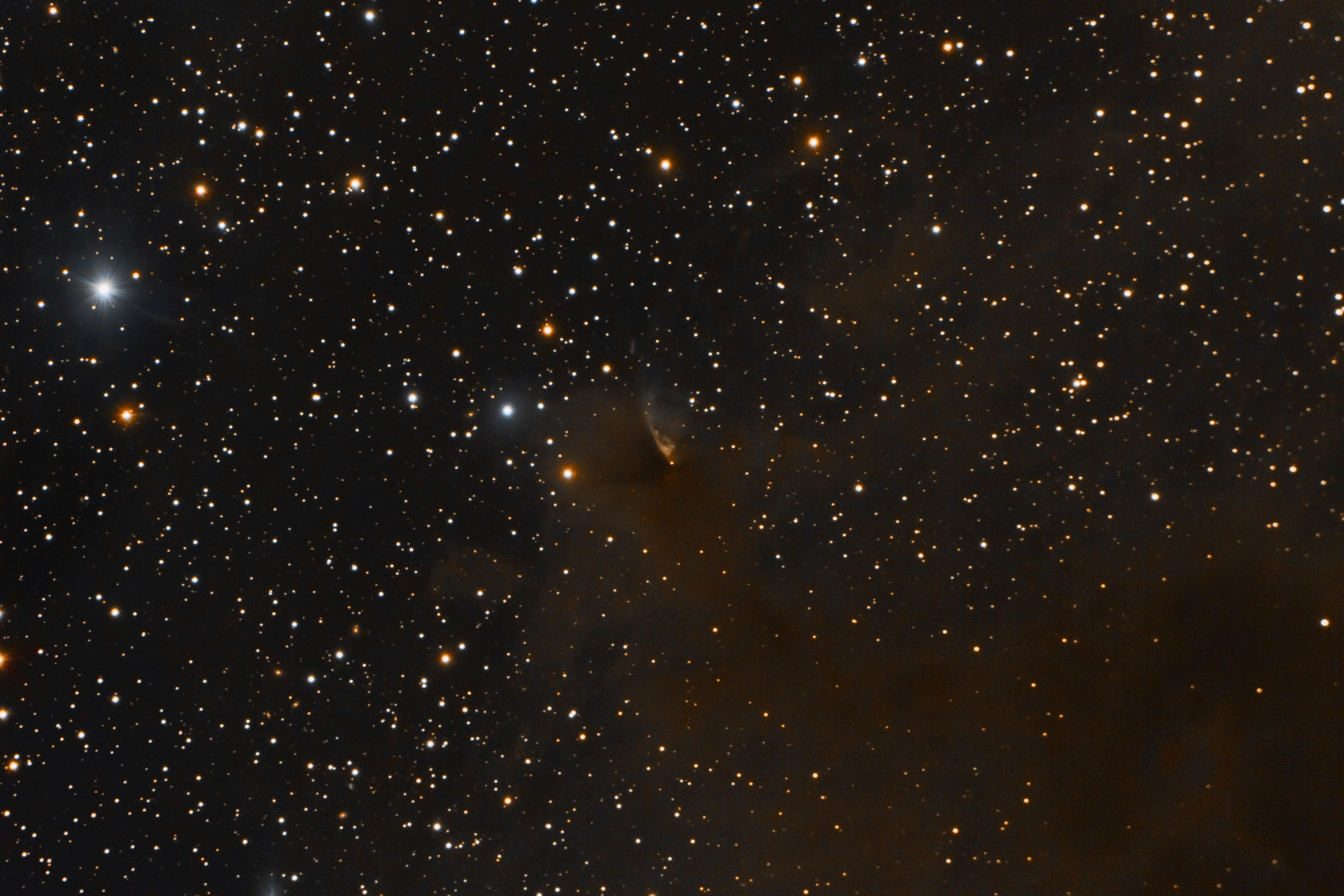
PV_CEP_L4X10RGB2X10.JPG
| In my entry of NGC 3079, I mentioned a nearby twin quasar just out of the field. Einstein's concept of gravity is a warping of space-time by an object with mass says that if you have a great enough mass it can deflect light much like a lens can bend light. This is called a "gravitational lens". Astronomers searched for decades but didn't turn up much. As scopes could go farther and farther into space a few candidates turned up. Some were seen and not recognized. This is an image of one of these unrecognized gravitational lenses. The first picture shows NGC 3079 at the very bottom with a "double star" circled. This is no star, however.
The close up below shows the "stars" to be blue in color. Eventually, some astronomer noticed that these were variable stars. Their light output varied slightly. So slightly it was best seen in a spectroscope as a change in the spectral lines along with a slight brightness variation. The odd thing was the spectra of these two objects was almost but not exactly the same. This was a bit of a puzzle as the spectra were very different from that of a star. In fact, it didn't match any known star type. To have two so close together made no sense. Nor could any lines be identified to help give a distance in case this was a galaxy rather than a star. Eventually, it was realized these were quasars. Star like objects so redshifted their spectra made no sense to astronomers used to "normal" redshifts. After more study, they realized this was not two objects but was one. This is the first gravitational lens to be recognized. The spectra were virtually identical if you took time into account. One spectrum lagged about 430 days behind the other! This meant the light traveled 430 light days further to reach us than the light making up the "other" quasar. The announcement was first made in 1979, Hubble answered another puzzle. The spectra of the lower object also had lines in it that were to be expected of a much nearer galaxy. It turns out this galaxy is the lens and at my resolution of about 2.5" of arc due to my local seeing it can't be seen. You need sub arc second resolution to separate the two. Something possible in space but not normally on earth at blue wavelengths. I see it only as the lower one being brighter as it is the light of both the lensed QSO and the galaxy. Hubble's image and a bit more on this guy can be seen at: http://www.astr.ua.edu/keel/agn/q0957.html
My exposure is very short due to clouds cutting me off and doesn't go very deep compared to most of my images. A nearby moon didn't help! Also, it is taken at 0.5" per pixel compared to my more normal 1" per pixel. The quasar images are 6" of arc apart (a quarter seen nearly one kilometer away). The quasar QSO 0957+561 is about 8.85 billion light-years away light travel time. The path followed by the upper image is 430 days shorter than the lower image.
14" LX200R @ f/10, L=4x10'x1 RGB=1x10'x2, STL-11000XM, Paramount ME Related Designations for QSO0957+561[HB89] 0957+561, SBS 0957+561, WISE J100120.68+555355.4, SDSS J100120.69+555355.6, LQAC 150+055 010, 87GB 095758.5+560808, 87GB[BWE91] 0957+5608, [WB92] 0957+5608, NVSS J100121+555355, VLSS J1001.3+5553, 6C B095757.6+560821, 7C 0957+5608, 8C 0958+561, TWIN QUASAR, TXS 0957+561, IERS B0957+561, RGB J1001+558C, WB J1001+5553, WIBRaLS J1001+5553, MS 0957.9+5607, RIXOS F252_031, E 0957+561, RX J1001.3+5553, RX J100120.3+555349, RX J100120.6+555355, 1RXS J100121.5+555351, AX J1001+5555, [YGK80] 0957+561, NGC 3079:[PTV98] H09, NGC 3079:[PTV98] P12, RX J1001.3+5553:[BEV98] 001, [JBB2007] J100120.69+555355.6 , [RLH2011] J1001+5553, QSO0957+561, TWIN QUASARS, | 
L4X10X1RGB1X10X2-20r.jpg
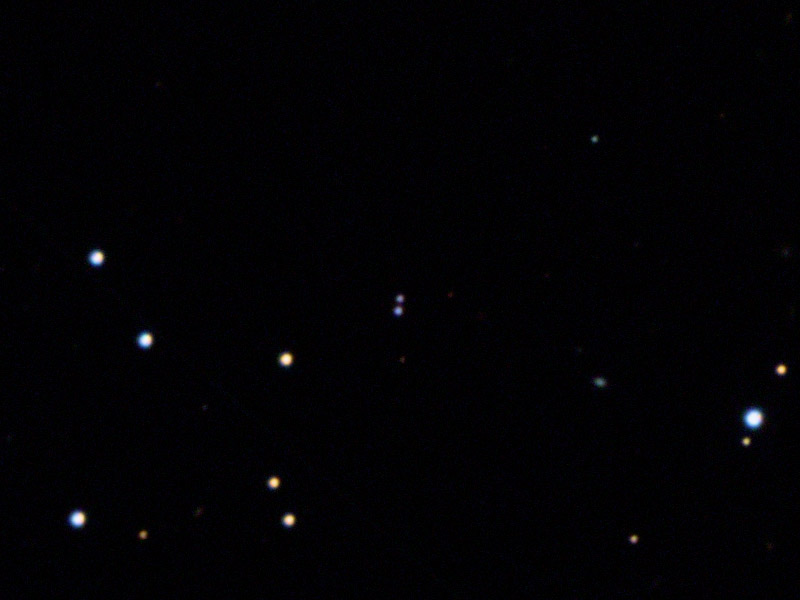
L4X10X1RGB1X10X2cropr.jpg
| The Amazing Randi had mentioned he hadn't seen the asteroid named for him so I made this movie of his asteroid from 7 10 minute luminance images. One frame has a piece of space junk flying through the top of the frame. Sky conditions went steadily downhill as clouds moved in forcing me to stop the movie. This is why the stars dim out as the animation progresses. He had it on his website for some time. It has vanished since he retired.
14" LX200R @ f/10 L=7x10', STL-11000XM, Paramount ME Related Designations for RANDIRANDI, | 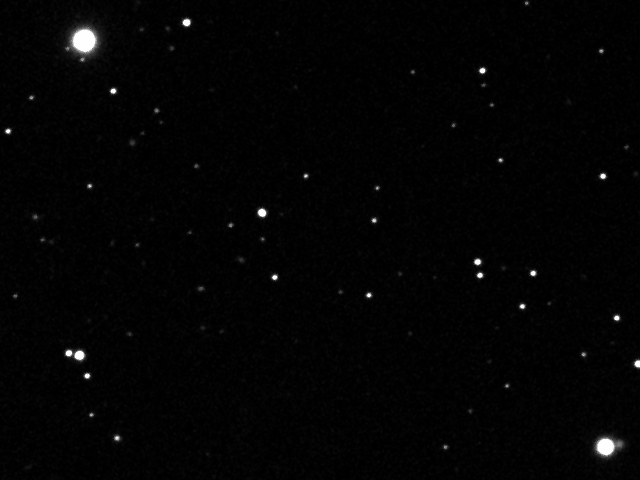
RANDIMOVIE.gif
| I know of nothing else like this object yet many of you probably never heard of it. Amateur images of it are rare. R Aquarii/HD 222800 is a most interesting variable star. It is a Mira type double star with a white dwarf companion with a period of around 44 years that can't be resolved (except maybe by the HST) but is seen in the spectrum. The pair form what is known as a symbiotic star at a distance of about 650 light-years from earth. The relationship has resulted in at least one, likely two, nova-like eruptions. The result of all this is a nebula around the star known as Cederblad 211 which consists of blue jets and red loops making for a very colorful nebula complex. There are two jets. The one running from the southwest to northeast is easy to see in my image. The smaller one going from the southeast to northwest is seen simply as making the star appear oval in shape. I was unable to resolve any more than that. The star is located at 15° south so down in my poor seeing low to the horizon. I had to try many nights just to get the seeing I did to capture this system. You can read a lot more about this star and nebula at http://www.aavso.org/vsots_raqr .
The star ranges rather widely in brightness. The minimum in current years is usually around magnitude 11 or lower but its brightest can hit 5th magnitude and it has been even brighter and dimmer. To best capture the nebula I had to wait for it to be near minimum which was only 1% of its normal brightest illumination. Unfortunately, conditions were poor at minimum I had to wait two weeks later when it was starting to rapidly brighten and move into my Meridian Tree. That meant fighting a moon, tree and the very short imaging time I have for objects this low. I had to go for it anyway or the star would be bright enough to cause real problems. Clouds then clobbered the green frames. One was sort of usable. Fortunately weak green is rather easy to compensate for. Especially since it has little green light. But, after years of trying I finally captured this elusive (for someone at my latitude) object.
The appearance of the nebula is said to change rather rapidly. Apparently, the illumination of it by the star is partly controlled by dust clouds moving around the star. As they move various parts of the nebula get more or less light. Unfortunately, this one is so low in my sky it is hard for me to get more than one night's view at a minimum when it isn't drowned out by a bright star. Though I suppose that too will change the nebula's appearance. Anyway, it is an interesting object to keep an eye on. I hope to revisit it again at another minimum. Hasn't happened as yet.
The HST probably has resolved the two stars. See this link for details: http://hubblesite.org/images/news/release/1990-15
I've seen claims the nebula can't be seen visually. While small I find that surprising. Those with large Dobs might want to take on this challenge. I can see it being lost when the star is bright but at minimum, I'd think it wouldn't be lost in the glare.
There are three asteroids in the image. All moving in direct motion which is rare for most of my images which have them moving in retrograde. So, in this case, they are moving from right to left. The one listed at 20th magnitude seems far fainter than what the Minor Planet Center predicted. The other two seem about right to me. It may be this one asteroid is very red and thus hitting the insensitive part of my chips response curve. Asteroid (76690) 2000 HZ73 passed right through a star. I'd have passed it off as an edge on galaxy if not for the Minor Planet Center pointing to the linear part as being an asteroid. I doubt there was an eclipse of the star as it appears just north of the star.
Only two galaxies have redshift data in NED. Both in the lower left corner. But for the asteroids, I'd not have made an annotated image.
14" LX200R @ f/10, L=4x10' RB=2x10' G=1x10', STL-11000XM, Paramount ME | 
HD222800L4X10RB2X10G1X10R-ID.JPG

HD222800L4X10RB2X10G1X10R.JPG
| The star is HD 44179 magnitude 8.85 about 1250 light years away. It is a post AGB star in the process of forming a proto-planetary nebula. I've run several planetary nebula but this is the first one in its early formative phase. These are formed as a star of similar mass as our sun runs out of fuel and contracts into a white dwarf. This final phase can cause the star to puff off its outer gas shell leaving only the inner core which then collapses into a white dwarf. This is a star that is in this short duration phase as it dies. Come back in a few thousand years and see if it was successful in forming such a planetary nebula. Why this forming gas shell would take on a nearly perfect rectangular shape is quite the mystery. Though the fact the star is really a close double star wrapped in dust envelop so thick we can't see the stars themselves, only the bright envelop they are in, may have something to do with the shape.
Without the earth's atmosphere screwing things up Hubble was able to get a really good view of this nebula.
The star is HD 44179 magnitude 8.85 about 1250 light years away. It is a post-AGB star in the process of forming a proto-planetary nebula. I've run several planetary nebulae but this is the first one in its early formative phase. These are formed as a star of similar mass as our sun runs out of fuel and contracts into a white dwarf. This final phase can cause the star to puff off its outer gas shell leaving only the inner core which then collapses into a white dwarf. This is a star that is in this short duration phase as it dies. Come back in a few thousand years and see if it was successful in forming such a planetary nebula. Why this forming gas shell would take on a nearly perfect rectangular shape is quite the mystery. Though the fact the star is really a close double star wrapped in dust envelop so thick we can't see the stars themselves, only the bright envelop they are in, may have something to do with the shape.
Without the earth's atmosphere screwing things up, Hubble was able to get a really good view of this nebula.
http://hubblesite.org/news_release/news/2004-11
At -10.6 it is down in my poor seeing.
In order not to lose the nebula to the star I had to 117 30 second images. Since the star is very blue (B8) I used the red images to make a pseudo luminosity image which was then colored by the RGB image made from all 117 images. Why is it red? Here's one possible answer.
http://www.space.com/scienceastronomy/070406_red_rectangle.html
One problem with this answer is that there's also what is known as the Red Square Nebula. It too is around a Post AGB star but is so red it is visible only in the infrared. Otherwise, it appears virtually the same (but more square) as the Red Rectangle.
http://www.abc.net.au/science/news/stories/2007/1895422.htm?space
My image is at 0.5" per pixel which really shows distortions from poor seeing.
14" LX200R @ f/10, R=34x30" G=42x30" B=41x30"
http://hubblesite.org/news_release/news/2004-11
At -10.6 it is down in my poor seeing.
In order not to lose the nebula to the star I had to 117 30 second images. Since the star is very blue (B8) I used the red images to make a pseudo luminosity image which was then colored by the RGB image made from all 117 images. Why is it red? Here's one possible answer.
http://www.space.com/scienceastronomy/070406_red_rectangle.html
One problem with this answer is that there's also what is known as the Red Square Nebula. It too is around a Post AGB star but is so red it is visible only in the infra red. Otherwise it appears virtually the same (but more square) as the Red Rectangle.
http://www.abc.net.au/science/news/stories/2007/1895422.htm?space
My image is at 0.5" per pixel which really shows distortions from poor seeing.
14" LX200R @ f/10, R=34x30" G=42x30" B=41x30" | 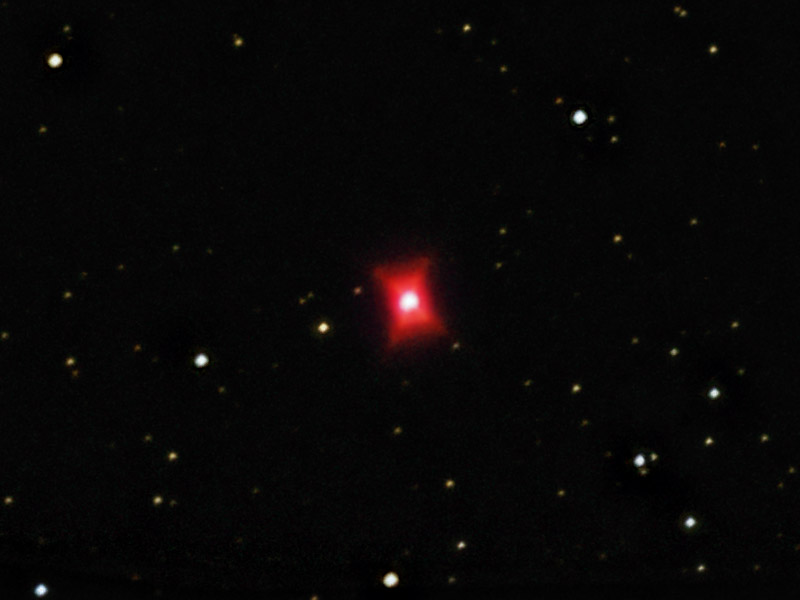
RED-RECTANGLE1.jpg
| SagDIG (Sagittarius Dwarf Irregular Galaxy) is a distant member of the local group at about 3.4 million light-years. The stars in it have been known for years to be extremely metal poor. By that they mean it's stars have very few elements other than hydrogen and helium. This could mean it is very young or very old. The Hubble Space Telescope determined the stars are mostly fairly old. 4 to 8 billion years meaning only yellow to red stars should be seen. Yet its stars are very blue. Blue stars live only a few million years, not the many billions of years this study shows them to be. Turns out very old stars can be blue as well when metal poor. The supernova in 1987 in the Large Magellanic Cloud was blue rather than red for this reason. Also, star formation is still going on in this galaxy though not at a high rate. The galaxy wasn't discovered until June 13, 1977 on a one meter telescope survey plate.
My image also shows it to be quite blue even though it is low in Sagittarius and seen through much of dust and gas of our galaxy. After reading how old it was I expected it to be red. I even convinced myself the HST image showing it blue was due to the use of narrow band filters. They were used but that's not why the image showed it blue. I should have realized this but it took my image to drive the concept through my thick skull. While most stars are very metal poor 27 possible carbon stars have been seen in it.
I'd wanted to image this one for years but at nearly 18 degrees south it was so low I needed an extraordinary night. I got one though being very low atmospheric dispersion created some color alignment issues. That also meant the luminance data wasn't quite as sharp as the night would have allowed otherwise. Still, I've had less resolution at the zenith so I can't complain. I'd have liked more time but at this time of the year, I have too little dark time in a night. No other night compared to the seeing this night so I went with what I could do in one night. This low I have to catch it east of the Meridian so my window for the year has closed.
There's an asteroid (27159) 1999 AA2 making a near horizontal trail to the upper right of SagDIG about halfway to the upper right corner. There are a couple others, much fainter. Due to the high star count, they are mostly hidden behind stars so I won't try and point them out or make an annotated image.
A high-resolution image by the Hubble Space Telescope can be seen at: https://www.spacetelescope.org/images/opo0431b/ It is oriented with north to the right rather than at the top as mine is.
14" LX200R @ f/10, L=4x10' RGB=2x10', STL-11000XM, Paramount ME Related Designations for SAGDIGSagittarius Dwarf Irregular, ESO 594- G 004, ESO 192706-1747.0, UKS 1927-177, Sagittarius Dwarf, SGR Dwarf, SGC 192706-1747.0, AGC 590011, HIPASS J1929-17, PGC 063287, 11HUGS 403, [SPB93] 260, SAGDIG, PGC63287, | 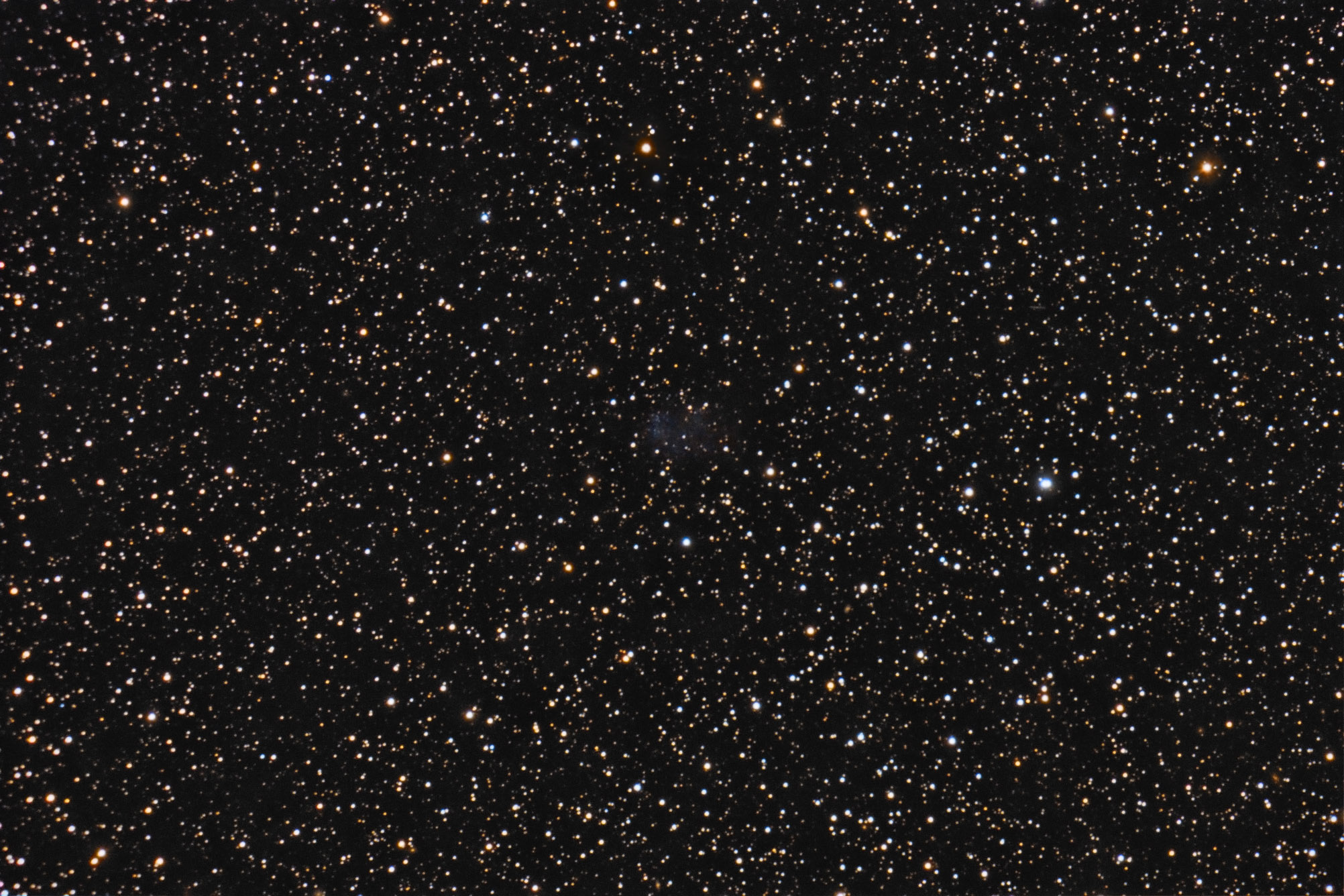
SAGDIG_L4X10RGB2X10.JPG
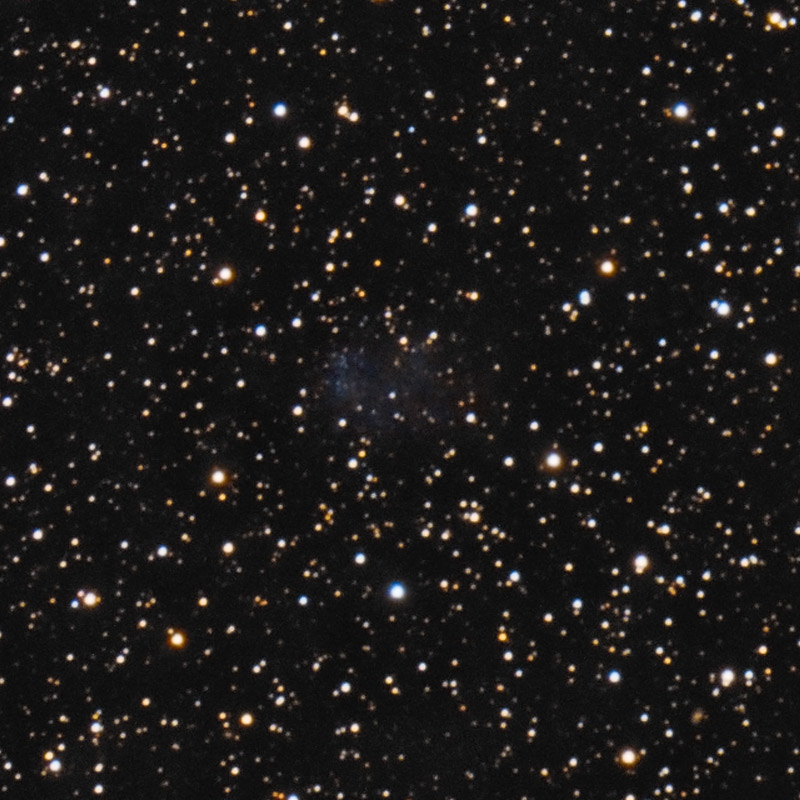
SAGDIG_L4X10RGB2X10CROP125.JPG
| Sedna is a large member of the Kuiper belt that goes the farthest out from the sun of those known at this time. Its orbit ranges from 76 AU to 937 AU. This makes it also a member of the inner Oort Cloud. Its orbital period is 11,400 years. It was about 86 AU when I took this image of it and about magnitude 21.3. It is currently moving toward the sun so is closer now than when I took this image though only slightly brighter. Its orbit may be one affected by the still hypothetical Planet Nine that has been invoked to explain the orbits of several similar trans-Neptunian objects. During the 1.5 hours used for my exposure, it moved only 0.74", too little at my image scale to detect. Its surface is unusually red and reflective so while it is one of the most distant members of our solar system it is also brighter than all other distant objects but larger and much whiter Eris. It's larger size also helps make it brighter than most of its distant companions. Current estimates put its diameter at about 995 ± 85 km (681 ± 52 miles). The galaxy at the top of my photo is UGC 2712, an SBd galaxy a bit over 300 million light-years distant.
14" LX200R @ f/10, L=6x10' RGB=2x10', STL-11000XM, Paramount ME Related Designations for SEDNASEDNA, | 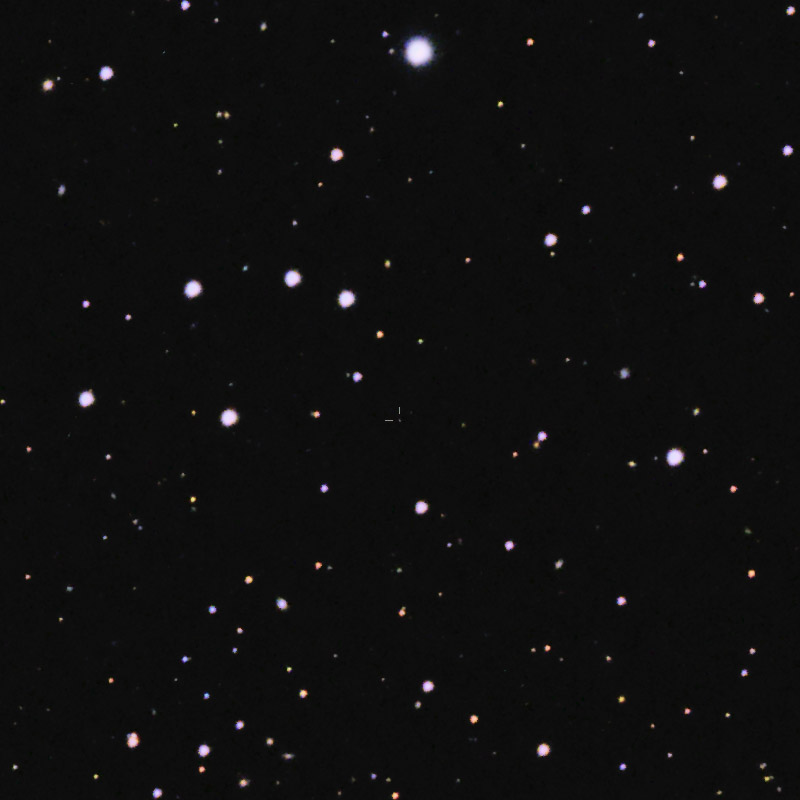
SEDNA-L4X10RGB1X10X3r-CROP.jpg
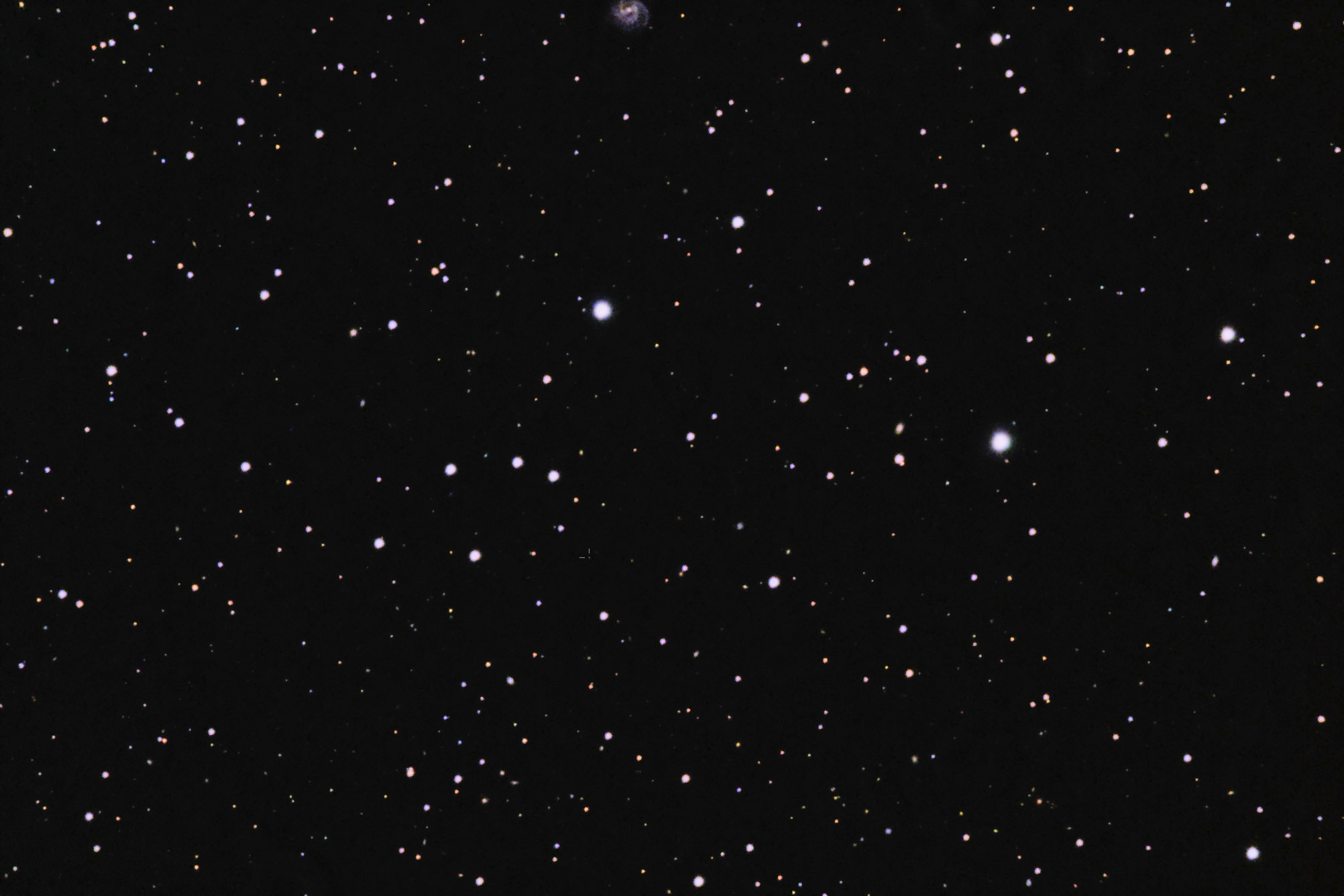
SEDNA-L4X10RGB1X10X3r.jpg
| 





























